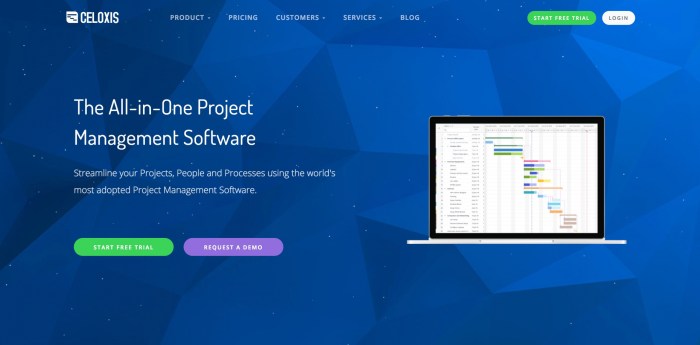All-in-one business software sets the stage for this enthralling narrative, offering a comprehensive solution that integrates various business functions into a single platform. This software encompasses a range of services such as project management, customer relationship management, accounting, and more, streamlining operations and enhancing productivity for businesses of all sizes. With notable examples like HubSpot and Zoho, these solutions have evolved significantly, becoming essential tools in modern business practices.
All-in-One Business Software

All-in-one business software refers to integrated solutions designed to streamline various business operations within a single platform. This type of software typically encompasses functions such as customer relationship management (CRM), project management, accounting, and human resources, enabling businesses to manage multiple tasks without relying on disparate systems. Popular examples include Salesforce, HubSpot, and Zoho, which offer a range of features that cater to different business needs. Historically, the evolution of all-in-one software has significantly impacted modern business practices, as companies increasingly seek ways to enhance efficiency and reduce operational complexity.
Definition and Overview of All-in-One Business Software

All-in-one business software encompasses a wide range of functionalities aimed at supporting the diverse needs of businesses. It includes core features like:
- CRM to manage customer interactions and data.
- Accounting tools for financial tracking and reporting.
- Project management capabilities to oversee timelines and tasks.
- Human resource modules for employee management and payroll.
The historical development of all-in-one software can be traced back to the increasing demand for efficiency and integration in business processes. As businesses have grown in size and complexity, the need for cohesive software solutions has become evident, making all-in-one software a significant tool in modern business practices.
Benefits of Using All-in-One Business Software
Utilizing all-in-one business software provides numerous advantages for companies, including:
- Centralized data management, which reduces data silos.
- Increased collaboration among teams due to shared access to information.
- Cost savings by cutting down on multiple software subscriptions.
- Improved productivity as users navigate a single platform rather than multiple systems.
Statistics show that businesses using integrated software solutions can experience a productivity boost of up to 30%. Case studies demonstrate that companies across various industries have successfully adopted all-in-one solutions to streamline their operations and enhance overall efficiency.
Key Features of All-in-One Business Software
Essential features common in all-in-one business software packages include:
- User-friendly interface for seamless navigation.
- Real-time reporting and analytics to monitor performance.
- Customizable dashboards to tailor views for different roles.
- Integration capabilities with other tools and applications.
Here is a comparison of key features across several popular all-in-one business software options:
| Feature | Salesforce | HubSpot | Zoho |
|---|---|---|---|
| CRM | Yes | Yes | Yes |
| Project Management | Yes | No | Yes |
| Accounting | Yes | No | Yes |
| HR Management | No | No | Yes |
These functionalities support a variety of business operations, ensuring that organizations can operate effectively in a competitive environment.
Choosing the Right All-in-One Business Software
When selecting all-in-one business software, businesses should consider several key criteria:
- Specific features and functionalities that meet business needs.
- User reviews and feedback from current users.
- Trial periods offered by software providers for hands-on evaluation.
- Pricing structures and scalability options for future growth.
- Customer support availability and responsiveness.
A comprehensive checklist for decision-making can aid in evaluating different software options, ensuring that all critical factors are considered before making a selection.
Implementation and Integration Strategies
Successfully implementing all-in-one business software requires strategic planning. Key steps include:
- Assessing current processes and identifying integration points.
- Training employees on the new system to ensure smooth transition.
- Setting clear objectives and milestones for the implementation phase.
- Monitoring progress and making adjustments as needed during rollout.
Establishing a timeline with key milestones helps to maintain focus and gauge success throughout the integration process.
Challenges and Considerations

Businesses may face several challenges when adopting all-in-one business software. Common issues include:
- Resistance to change among employees.
- Integration difficulties with existing systems.
- High initial costs, particularly for small businesses.
- Underestimating the training required for staff.
To overcome these obstacles, businesses can engage in proactive change management, provide ample training resources, and establish a supportive environment for users to adapt to the new system.
Future Trends in All-in-One Business Software
Emerging trends in the development of all-in-one business software include:
- Increased reliance on artificial intelligence to enhance user experience and automate tasks.
- Greater focus on mobile accessibility for remote and on-the-go management.
- Incorporation of data analytics to provide deeper insights into business performance.
- Integration of cloud-based solutions to support scalability and flexibility.
Staying updated with technological advancements is crucial for businesses to remain competitive and leverage new capabilities offered by software solutions.
Case Studies of Successful All-in-One Software Implementation
Several businesses have successfully implemented all-in-one software, resulting in significant transformations. For instance, a mid-sized retail company adopted an all-in-one solution that integrated their inventory, sales, and customer service systems. Post-implementation, they experienced a 25% increase in sales efficiency and a 40% reduction in administrative overhead.
Another case involves a manufacturing firm that utilized an all-in-one solution to streamline production scheduling and resource allocation. This led to decreased downtime and improved overall operational output.
These examples illustrate the powerful impact of well-implemented all-in-one business software, showcasing strategies that contribute to successful outcomes.
Concluding Remarks: All-in-one Business Software
In conclusion, the implementation of all-in-one business software can transform organizational efficiency and effectiveness. By consolidating various functions into one system, businesses can not only save time and resources but also gain valuable insights that drive growth and innovation. As companies continue to embrace technological advancements, the future of all-in-one software looks promising, paving the way for enhanced collaboration and smarter decision-making.